|
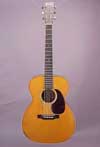
|
A fine instrument indeed! It's a 1935 Martin 000-28, made in the first
year after Martin abandoned the use of bar frets in favor of the modern T-frets. This
guitar has been in the family of the original owner and has suffered no real damage
in its life. It has never had any repair work that I could detect, and needed only
to have the neck reset to restore the original geometry and allow for good playing
action.
Click
here for more details about neck angle diagnosis. |
|

|
You can see that the action had risen considerably with all those
years of string tension. Ideally, there would be about 3/32" between the 12th
fret and the bottom of the low E string. Even with a low saddle, this guitar has
twice that much clearance. No choice but to reset the neck. |
|

|
I like the rubber heating elements sold by L.M.I. They're attached
to a timer, so if I get called away, I won't be likely to start a fire! I wrap the
element in aluminum foil to keep it clean. I also have a sandbag to hold the wire
so the heating element won't shift position. |
|

|
To keep the heat from loosening the fingerboard over the neck of the
guitar, I insulate it with a slip of 1/8" thick wood. I try to get the fingerboard
hot enough so I can feel real warmth inside, under the top. |
|
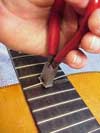
|
As soon as I remove the heat blanket, while the frets are still hot,
I pull out the 15th. |
|

|
Once the fingerboard is hot enough to weaken the glue, I can slip
under there with a broad knife to separate the fingerboard from the guitar top without
damage to either spruce or ebony. |
|
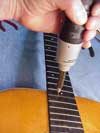
|
The end of the dovetail pocket lies just under the 15th fret on most
Martin guitars, so I drill a 1/16" hole through the 15th fret slot. Here, I'm
using my power screwdriver with a hex shank 1/16" bit. How did we get along
without power screwdrivers? |
|
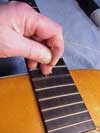
|
To double check whether I've hit the pocket at the end of the dovetail
joint, I probe with a piece of an old guitar string. |
|

|
Here's my reset tensioning jig. It's a simple clamping device that
pulls up on the neck. |
|
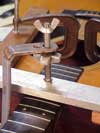
|
When I tighten the fat aluminum wing nut, the 3/16" steel strap
applies tension at the heel. In fact, the strap bends quite a bit, so that when the
neck begins to loosen, it continues to pull for about 1/2" - enough for the
neck to pop free of the joint. |
|

|
At the bottom end of the strap, there's a wooden leather covered pad
to protect the heel. |
|

|
I particularly like this jig because it relies on leverage to handle
the tension, so I can use some very compact and light clamps to hold it to the top
braces. When it's in position, I can maneuver the guitar almost as easily as if it
weren't there. |
|
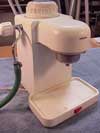
|
Some years ago I witnessed a demonstration at the Northwoods Guitar
Repair Seminar in Big Rapids Michigan, where Roger Fritz of the Gibson repair department
steamed out the neck of a Les Paul model guitar. Since then, I, too, have been using
an espresso machine as my steam source. It's really great. Five bucks at a garage
sale, and a few minutes plugging the coffee section, and I have a great, safe steamer
with a convenient shutoff valve. |
|

|
I've used regular reinforced air hose, but finally invested a few
more bucks on some high temperature rubber hose. The steam needle is just like the
ones sold by Stewart MacDonald. I made mine some years ago from 1/16" O.D. thick
walled stainless tubing. |
|
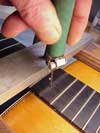
|
I don't have a handle for the "business end" of my steam
hose, so sometimes I use a rag to grip it when it gets hot. |
|
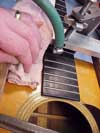
|
In place, and starting to steam. I always have plenty of dry rags
handy to mop up hot water and steam as it comes out of the joint, usually under the
fingerboard.
Sometimes, the steam goes inside the body. If that happens, I stick my shop vac hose
inside (using a reduced size, about the size of a home vacuum hose) to suck the steam
away quickly, in addition to stuffing lots of rags in there. |
|

|
Yikes! Well, I did say "usually under the fingerboard."
In this case, steam belched out at the "south end" of the heel, right at
the back. Naturally, I backed off on the steam valve a bit. |
|

|
That's where this jig really shines. I can bounce the guitar all over
the place while I'm steaming, so I keep on top of steam damage control. |
|
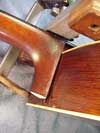
|
And, suddenly, just as I'm wiggling the neck around to loosen it,
the neck pops free, jumps up, hits the top of the jig and is out with nary a scratch
or steam mark. That's why I have duct tape on the steel strap. When the neck comes
out, the strap drops away, and might scratch the instrument in the process. |
|

|
Often, I'll take advantage of the residual pressure to "steam
clean" some of the parts. |
|

|
A quick touch with a scraper gives me a fresh gluing surface. |




















